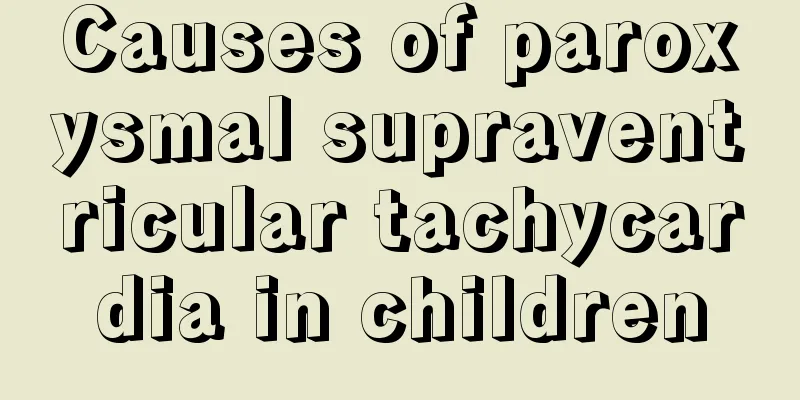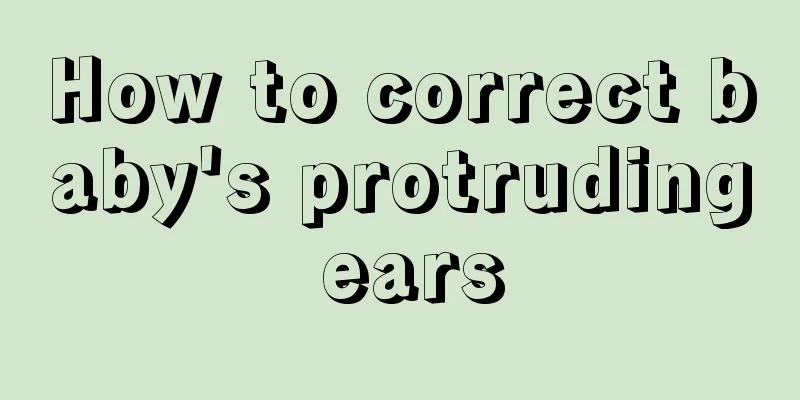Causes of paroxysmal supraventricular tachycardia in children

|
Paroxysmal supraventricular tachycardia in children is abbreviated as SVT, which is also divided into congenital factors. This disease is prone to relapse, which may be caused by acute infection. There are many causes of this disease, such as atrial septal defect, cardiac catheterization, and heart surgery, which may all cause paroxysmal supraventricular tachycardia. The clinical manifestations are sudden onset or sudden cessation, which can occur in any age group, but is more common in infants. My aunt's child was only over a month old and had a sudden onset. He refused to eat and kept vomiting. Causes of paroxysmal supraventricular tachycardia in children (I) Causes of the disease: Paroxysmal supraventricular tachycardia is common in children without organic heart disease. Children with preexcitation syndrome are prone to supraventricular tachycardia and are prone to recurrence. Acute infection may be a trigger. Supraventricular tachycardia can also occur in organic heart diseases, such as rheumatic carditis, tricuspid valve displacement, atrial septal defect, etc. Supraventricular tachycardia can also occur in digitalis poisoning, cardiac catheterization, and heart surgery. (II) Pathogenesis: Cardiac electrophysiological studies suggest that supraventricular tachycardia is mostly caused by reentry, and a few are caused by increased automaticity. Reentry can occur in the sinoatrial node, atrium, atrioventricular node and atrioventricular accessory pathway, among which atrioventricular accessory pathway and atrioventricular node reentry are the most common. Beijing Children's Hospital used transesophageal atrial pacing to conduct electrophysiological studies on 34 children with supraventricular tachycardia. The results showed that 19 cases (56%) had atrioventricular accessory pathway reentry, 13 cases (38%) had atrioventricular nodal reentry, and 2 cases (6%) had increased atrial automaticity. Chongqing Children's Hospital used the same method to study the pathogenesis of 27 children with supraventricular tachycardia. Among the 22 cases with confirmed classification, 63% were atrioventricular accessory pathway reentry, followed by atrioventricular nodal reentry. 1. Reentry mechanism For reentry to occur, three factors must be present: unidirectional conduction block, conduction delay and reentry loop. (1) Atrioventricular node reentry: Figure 1 shows that the atrioventricular node is longitudinally separated into two pathways: the slow pathway (α pathway) has slow conduction and a short refractory period; the fast pathway (β pathway) has fast conduction and a long refractory period. In normal sinus rhythm, atrial impulses are transmitted through both the fast and slow pathways, with the fast pathway generating the QRS wave. However, when the impulse is transmitted to the atrioventricular bundle through the slow pathway, the latter is in the refractory period of the fast pathway and is blocked. If there is a premature atrial contraction, the fast pathway is still in the refractory period and a unidirectional block occurs. The impulse is transmitted down the slow pathway to produce a QRS wave, and then retrogradely transmitted along the fast pathway to produce an atrial echo. If atrial premature contraction occurs earlier, when the atrial echo is transmitted to the slow pathway, the latter has already left the refractory period, thus forming atrioventricular nodal reentrant supraventricular tachycardia (AVNRT). The type in which the disease is transmitted downward by the slow pathway and retrogradely by the fast pathway is called the slow-fast type (S-FAVNRT), which is more common. The type in which the disease is transmitted downward by the fast pathway and retrogradely by the slow pathway is called fast-slow type (F-SAVNRT), which is relatively rare. (2) Atrioventricular reentry: that is, preexcitation syndrome complicated by supraventricular tachycardia. The atrioventricular node is the slow pathway, the atrioventricular accessory pathway is the fast pathway, and the reentry circuit includes the atrioventricular node, ventricular muscle, atrioventricular accessory pathway and atrial muscle. Atrioventricular reentrant supraventricular tachycardia (AVRT) is usually triggered by a timely premature atrial contraction. The impulse is blocked in the accessory pathway, transmitted forward along the atrioventricular node, and then retrogradely reenters through the accessory pathway when it reaches the ventricle, forming atrioventricular reentrant supraventricular tachycardia. The antegrade conduction from the atrioventricular node and the retrograde conduction from the accessory pathway is called antegrade atrioventricular reentrant supraventricular tachycardia. The retrograde conduction through the accessory pathway and atrioventricular node is called retrograde atrioventricular reentrant supraventricular tachycardia, which is extremely rare. For example, the atrioventricular accessory pathway in preexcitation syndrome has only one-way retrograde function. The electrocardiogram shows no signs of ventricular preexcitation (normal PR interval, no delta wave), but antegrade atrioventricular reentrant supraventricular tachycardia can still form through the bypass pathway, which is called latent preexcitation syndrome. Among the 19 patients diagnosed with AVRT by transesophageal atrial pacing at Beijing Children's Hospital, 6 (31%) had latent preexcitation syndrome. (3) Sinoatrial node reentry and intraatrial reentry: Both are less common. Sinoatrial node reentry often occurs in patients with sick sinus syndrome; intraatrial reentry is seen in patients with organic heart disease with atrial enlargement. 2. Increased automaticity: Due to the increased slope of phase 4 automatic depolarization in the atria or atrioventricular node area, ectopic impulses are formed, which often occurs in patients with organic heart disease. Factors such as hypoxia, catecholamines and side effects of digitalis can enhance the automaticity of the atria and atrioventricular node. Automatic atrial tachycardia in children may be caused by residual automatic embryonic cells in the atrial muscle. In terms of diet, you should avoid overeating, reduce salt intake, eat light food on a regular basis, and reduce cholesterol intake. Eat more easily digestible foods, such as fresh vegetables and fruits. Finally, we can summarize previous outbreaks and experience to avoid the onset of the disease. |
<<: What is spastic cerebral palsy?
>>: What to do if your child has diarrhea
Recommend
How to care for baby neck eczema?
Many babies will develop eczema during the confin...
How to cultivate children's habits
Many families do not pay attention to their child...
What to do if your child has herpes in his mouth
Children are the apple of their parents’ eyes, an...
Children's height standards, international height standards reference
For every parent, the height of the child is also ...
What should I do if my 12-year-old child has a fever?
In the growth process of every child, problems of...
Is it really good to bathe your baby every day?
I believe many mothers understand that babies wil...
The reason why babies have swollen eyes in the morning
In fact, in daily life, many people who have just...
Will teething cause bleeding in babies?
The growth of baby's deciduous teeth is an im...
What kind of complementary food is good for a two-month-old baby?
Babies need to eat complementary foods after two ...
How to care for baby rash
Babies are prone to rashes in the summer. Parents...
What causes the baby's stomach to make noises when feeding?
Many young mothers will find a somewhat strange p...
Will children not grow taller if they learn hip-hop dancing?
Street dance is a very popular dance in the West....
Causes of high hemoglobin in children
If a child has high hemoglobin, it is particularl...
Baby's eyes are swollen due to allergies
Babies' body resistance is not that good. If ...
Parents must read this article to understand the symptoms of food poisoning in children!
When children have food poisoning, a series of sy...









